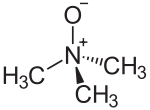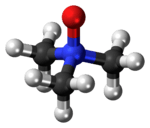Trimethylamine N-oxide
| Trimethylamine N-oxide | |
|---|---|
 | |
 | |
| IUPAC name trimethylamine oxide | |
| N,N-dimethylmethanamine oxide | |
| Other names trimethylamine oxide, TMAO, TMANO | |
| Identifiers | |
| CAS number | 1184-78-7 |
| PubChem | 1145 |
| ChemSpider | 1113 |
| UNII | FLD0K1SJ1A |
| KEGG | C01104 |
| ChEBI | CHEBI:15724 |
| Jmol-3D images | {{#if:C[N+](C)(C)[O-]|Image 1 |
| |
| |
| Properties | |
| Molecular formula | C3H9NO |
| Molar mass | 75.11 g mol−1 |
| Appearance | colourless solid |
| Melting point | 220–222 °C (hydrate: 96 °C) |
| Solubility in water | good |
| Except where noted otherwise, data are given for materials in their standard state (at 25 °C (77 °F), 100 kPa) | |
| Infobox references | |
Trimethylamine N-oxide (TMAO) is the organic compound in the class of amine oxides with the formula (CH3)3NO. This colorless solid is usually encountered as the dihydrate. It is a product of the oxidation of trimethylamine and a common metabolite in animals. It is an osmolyte found in saltwater fish, sharks and rays, molluscs, and crustaceans. It is a protein stabilizer that may serve to counteract urea, the major osmolyte of sharks, skates and rays. It is also higher in deep-sea fishes and crustaceans, where it may counteract the protein-destabilizing effects of pressure.[1] TMAO decomposes to trimethylamine (TMA), which is the main odorant that is characteristic of degrading seafood.
Synthesis
Treatment of aqueous trimethylamine with hydrogen peroxide affords the dihydrate (Me = CH3):[2]
- H2O2 + Me3N → H2O + Me3NO
Trimethylamine-N-oxide is biosynthesized from trimethylamine, which is derived from choline.[3]
Trimethylaminuria
Trimethylaminuria is a defect in the production of the enzyme flavin containing monooxygenase 3 (FMO3).[4][5] Those suffering from trimethylaminuria are unable to convert choline-derived trimethylamine into trimethylamine oxide. Trimethylamine then accumulates and is released in the person's sweat, urine, and breath, giving off a strong fishy odor.
Laboratory applications
Trimethylamine oxide is used in protein folding experiments to counteract the unfolding effects of urea.[6]
In the organometallic chemistry reaction of nucleophilic abstraction, Me3NO is employed as a decarbonylation agent according to the following stoichiometry:
- M(CO)n + Me3NO + L → M(CO)n-1L + Me3N + CO2
This reaction is used to decomplex organic ligands from metals, e.g. from (diene)Fe(CO)3.[2]
It is used in certain oxidation reactions, e.g. the conversion of alkyl iodides to the aldehyde.[7]
Health issues
Studies published in 2013 indicate that the concentration of TMAO in the blood increases after consuming foods containing carnitine[8] or lecithin[9] if the bacteria that convert those substances to TMAO are present in the gut.[10] High concentrations of carnitine are found in red meat, some energy drinks, and some dietary supplements; lecithin is found in eggs[10] and as an ingredient in processed food. Some types of normal gut bacteria (e.g. species of Acinetobacter) in human's microbiome convert dietary carnitine to TMAO. TMAO alters cholesterol metabolism in the intestines, in the liver, and in artery wall. In the presence of TMAO, cholesterol has increased deposition of cholesterol in, and decreased removal of cholesterol from, peripheral cells such as those in the artery wall.[11] Vegan and vegetarian diets appear to select against gut flora that metabolize carnitine (in favor of other gut flora more coordinated with their food supply). This apparent difference in their microbiome is associated with substantially reduced gut bacteria capable of converting carnitine to TMAO.[12][8]
Another source of TMAO is dietary phosphatidylcholine, again by way of bacterial action in the gut. Phosphatidyl choline is present at high concentration in egg yolks and some meats.
References
- ↑ Yancey, P. (2005). "Organic osmolytes as compatible, metabolic, and counteracting cytoprotectants in high osmolarity and other stresses". J. Exp. Biol. 208 (15): 2819–2830. doi:10.1242/jeb.01730. PMID 16043587.
- ↑ 2.0 2.1 A. J. Pearson "Trimethylamine N-Oxide" in Encyclopedia of Reagents for Organic Synthesis John Wiley & Sons, 2001: New York. doi:10.1002/047084289X.rt268
- ↑ Baker, J.R.; Chaykin, S. (1 April 1962). "The biosynthesis of trimethylamine-N-oxide". J. Biol. Chem. 237 (4): 1309–13. PMID 13864146.
- ↑ Treacy, E.P.; Akerman, BR et al. (1998). "Mutations of the flavin-containing monooxygenase gene (FMO3) cause trimethylaminuria, a defect in detoxication". Human Molecular Genetics 7 (5): 839–45. doi:10.1093/hmg/7.5.839. PMID 9536088.
- ↑ Zschocke J, Kohlmueller D, Quak E, Meissner T, Hoffmann GF, Mayatepek E (1999). "Mild trimethylaminuria caused by common variants in FMO3 gene". Lancet 354 (9181): 834–5. doi:10.1016/S0140-6736(99)80019-1. PMID 10485731.
- ↑ Zou, Q. et al. (2002). "The Molecular Mechanism of Stabilization of Proteins by TMAO and Its Ability to Counteract the Effects of Urea". J. Am. Chem. Soc. 124 (7): 1192–1202. doi:10.1021/ja004206b. PMID 11841287.
- ↑ Volker Franzen (1973), "Octanal", Org. Synth.; Coll. Vol. 5: 872
- ↑ 8.0 8.1 Koeth, Robert A; Zeneng Wang, Bruce S Levison, Jennifer A Buffa, Elin Org, Brendan T Sheehy, Earl B Britt, Xiaoming Fu, Yuping Wu, Lin Li, Jonathan D Smith, Joseph A DiDonato, Jun Chen, Hongzhe Li, Gary D Wu, James D Lewis, Manya Warrier, J Mark Brown, Ronald M Krauss, W H Wilson Tang, Frederic D Bushman, Aldons J Lusis & Stanley L Hazen (Published online April 7, 2013). "Intestinal microbiota metabolism of l-carnitine, a nutrient in red meat, promotes atherosclerosis". Nature Medicine 19 (5): 576–85. doi:10.1038/nm.3145. PMC 3650111. PMID 23563705. Retrieved April 26, 2013.
- ↑ Tang, W.H. Wilson; Zeneng Wang, Bruce S. Levison, Robert A. Koeth, Earl B. Britt, Xiaoming Fu, Yuping Wu, Stanley L. Hazen (April 25, 2013). "Intestinal Microbial Metabolism of Phosphatidylcholine and Cardiovascular Risk". The New England Journal of Medicine (368): 1575–1584. doi:10.1056/NEJMoa1109400. Retrieved April 26, 2013. "The production of TMAO from dietary phosphatidylcholine is dependent on metabolism by the intestinal microbiota. Increased TMAO levels are associated with an increased risk of incident major adverse cardiovascular events"
- ↑ 10.0 10.1 Gina Kolata (April 24, 2013). "Eggs, Too, May Provoke Bacteria to Raise Heart Risk". The New York Times. Retrieved April 25, 2013.
- ↑ Hazen, Stanley. "New Research On Red Meat And Heart Disease". The Diane Rehm Show (Transcript). WAMU 88.5 American University Radio. Retrieved 10 April 2013.
- ↑ Kolata, Gina (April 7, 2013). "Study Points to a New Culprit in Heart Disease". The New York Times. Retrieved 2013-04-07.